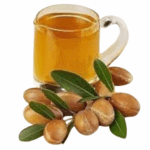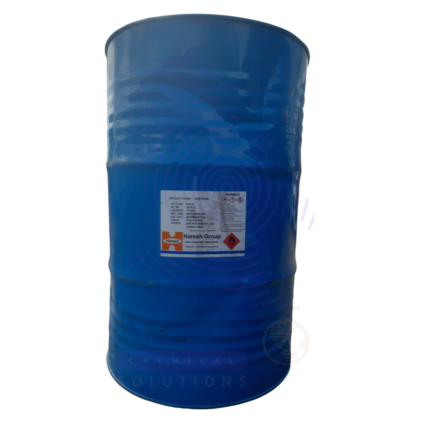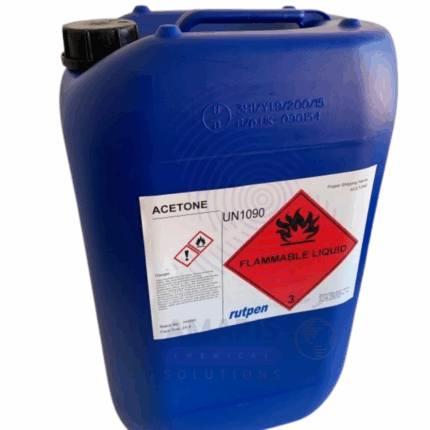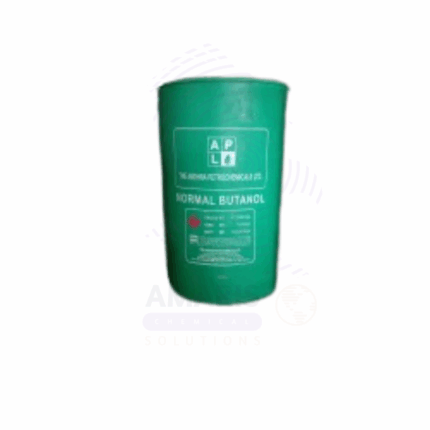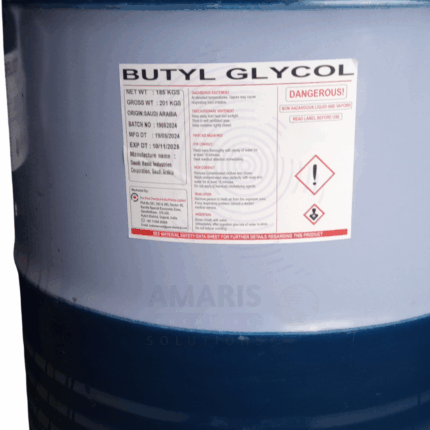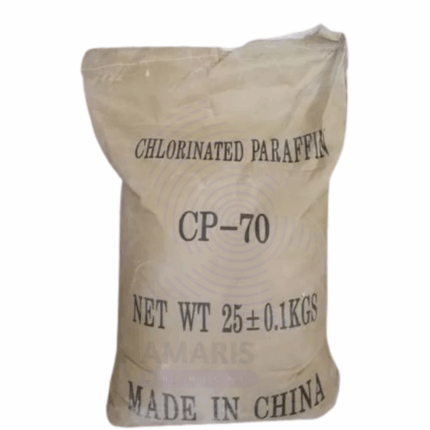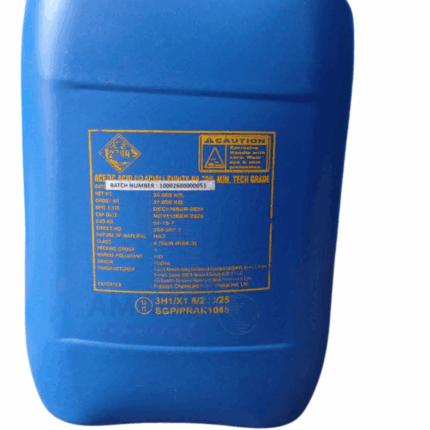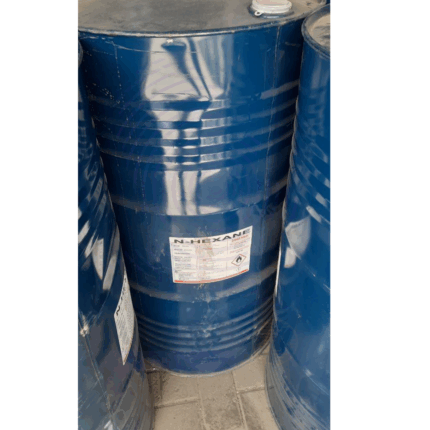Perchloroethylene
Whatsapp Order
Perchloroethylene (also known as tetrachloroethylene or PCE) is a clear, colorless liquid with a sweet odor, widely used as a solvent in dry cleaning and industrial degreasing. It has excellent solvent power for organic materials, is non-flammable, and chemically stable under normal conditions. Perchloroethylene is valued for its efficiency in removing oils, greases, and waxes from fabrics and metals, and serves as a key chemical intermediate in various industrial applications.
Description
Table of Contents
Toggle
Perchloroethylene
Primary Uses
- Dry Cleaning Solvent
- The primary solvent used in commercial dry cleaning for removing oils, stains, and dirt from textiles without damaging the fabric.
- Provides effective cleaning with minimal fabric shrinkage or color loss.
- Industrial Degreasing
- Used to clean metal parts, machinery components, and electronic equipment by dissolving grease, oils, and wax residues.
- Suitable for vapor degreasing and cold cleaning processes.
- Chemical Intermediate
- Employed as a raw material in the manufacture of fluorocarbons and other chemical products.
- Extraction Solvent
- Used in laboratories and industrial processes to extract organic compounds from mixtures.
Secondary Uses
- Adhesive and Coatings Manufacturing
- Utilized as a solvent in adhesive formulations and specialty coatings.
- Textile and Leather Processing
- Applied in cleaning and finishing processes for textiles and leather goods.
- Pesticide Formulations
- Acts as a solvent carrier in certain pesticide products.
- Electronics Industry
- Used for cleaning delicate electronic components during manufacturing.
KEY PRODUCT FEATURES
1. Basic Identification Attributes
- Chemical Name (IUPAC): Tetrachloroethylene
- Common/Trade Name: Perchloroethylene, PCE, Tetrachloroethene
- CAS Number: 127-18-4
- HS Code: 2903.39.00
- Synonyms: Perc, Dry cleaning solvent, Tetrachloroethene
2. Physical & Chemical Properties
- Physical State: Clear, colorless liquid
- Color & Odor: Odorless to sweet aromatic odor
- Boiling Point: 121°C
- Melting Point: -22.8°C
- Density: 1.62 g/cm³ at 20°C
- Solubility: Slightly soluble in water; miscible with most organic solvents
- Vapor Pressure: 18.3 kPa at 25°C
3. Safety & Hazard Attributes
- GHS Classification: Hazardous (Carcinogenic, harmful if inhaled or swallowed, causes skin and eye irritation)
- Toxicity: Moderate to high toxicity; potential carcinogen (IARC Group 2A)
- Exposure Limits: OSHA PEL - 100 ppm (8-hour TWA)
4. Storage & Handling Attributes
- Storage Conditions: Store in a cool, well-ventilated area away from heat and ignition sources
- Container Type: Supplied in sealed metal drums or chemical-grade containers
- Shelf Life: Stable for several years if stored properly
- Handling Precautions: Use personal protective equipment; avoid inhalation and prolonged skin contact
5. Regulatory & Compliance Attributes
- Complies with EPA, OSHA, and REACH regulations
- Listed under various chemical inventories and reporting requirements
- Subject to strict environmental discharge and workplace exposure limits
6. Environmental & Health Impact
- Biodegradability: Poorly biodegradable; persistent in environment
- Ecotoxicity: Toxic to aquatic life; avoid release into waterways
- Bioaccumulation: Potential for bioaccumulation in aquatic organisms
- Carcinogenicity/Mutagenicity: Classified as a probable human carcinogen (IARC Group 2A)
SAFETY HANDLING PRECAUTIONS
Safety Handling Precautions
- PPE Required: Respirators, gloves, chemical goggles, and protective clothing
- Handling Guidelines: Use in well-ventilated areas or under fume hoods; avoid skin and eye contact
- Storage Measures: Keep containers tightly closed; prevent vapor release
First Aid Measures
- Inhalation: Move to fresh air immediately; seek medical attention if breathing difficulty occurs
- Skin Contact: Wash with soap and water; remove contaminated clothing
- Eye Contact: Rinse thoroughly with water for at least 15 minutes; seek medical attention
- Ingestion: Do not induce vomiting; seek immediate medical help
Firefighting Measures
- Fire Hazards: Non-flammable but decomposes to produce toxic gases under fire conditions
- Extinguishing Media: Use water spray, foam, dry chemical, or CO₂
- Special Precautions: Firefighters must wear self-contained breathing apparatus (SCBA)
- Hazardous Combustion Products: Phosgene, hydrogen chloride, carbon monoxide, and other toxic gases
Related products
Acetone
Acetone Extra Pure is a high-purity grade of acetone (≥99.5%) specifically purified to meet stringent quality standards for laboratory and industrial applications. This volatile, colorless solvent is characterized by its rapid evaporation rate, excellent solvency power, and minimal impurity content, making it suitable for sensitive chemical processes and analytical applications
Butanol
Butanol (also known as n-Butanol or Normal Butanol) is a clear, colorless liquid with a mild, alcoholic odor. It is a four-carbon primary alcohol with the chemical formula C4H10O. Butanol is moderately soluble in water and miscible with many organic solvents. Its physical and chemical properties make it a versatile solvent and chemical intermediate. Butanol indicates a high purity grade often used in industrial, pharmaceutical, and chemical synthesis applications.
Butyl Glycol
Butyl Glycol, also known as 2-Butoxyethanol, is a colorless to pale yellow liquid with a mild, sweet ether-like odor. It is an organic solvent classified as a glycol ether, with the molecular formula C6H14O2. Butyl Glycol is highly miscible with water, alcohols, and many organic solvents. It is widely used in industrial and commercial applications due to its excellent solvent properties, low volatility, and moderate toxicity. Its high solvency and compatibility with both aqueous and organic phases make it valuable in coatings, cleaning products, inks, and adhesives.
Chlorinated Paraffin Wax
Chlorinated Paraffin Wax is a synthetic chlorinated hydrocarbon obtained by the chlorination of paraffin wax. It typically appears as a waxy solid, ranging from light yellow to dark brown depending on the degree of chlorination and the chain length of the paraffins. CPW is valued for its excellent flame retardant, plasticizing, and extreme pressure (EP) additive properties. It is widely used in industrial applications including metalworking fluids, PVC formulations, rubber compounding, and flame retardant materials. CPW offers thermal stability, chemical resistance, and lubricating qualities, making it a versatile industrial additive.
Glacial Acetic Acid Tech grade
Glacial Acetic Acid Tech grade is a clear, colorless liquid with a pungent vinegar-like odor. It is a less refined form of acetic acid primarily used for industrial and technical applications rather than food or pharmaceutical uses. Typically available in concentrations ranging from 80% to glacial (99-100%), it serves as a crucial chemical reagent, solvent, and intermediate in various industrial processes.
Isopropyl Alcohol Tech Grade
Isopropyl Alcohol Tech Grade is a colorless, flammable liquid with a strong, characteristic alcohol odor. It is a solution containing approximately 85% isopropanol by volume, with the remainder primarily water. This technical-grade IPA is widely used as a solvent, disinfectant, and cleaning agent in industrial, pharmaceutical, and household applications. The 85% concentration balances efficacy with safety and evaporation rate, making it versatile for various uses.
Normal Hexane
Normal Hexane is a colorless, highly flammable liquid hydrocarbon with the chemical formula C6H14. It belongs to the aliphatic hydrocarbon family and is primarily used as a solvent due to its excellent ability to dissolve oils, fats, and various organic compounds. It has a low boiling point and evaporates quickly, making it ideal for industrial and laboratory applications.
Xylene
Xylene is a clear, colorless, flammable aromatic hydrocarbon solvent consisting of three isomers: ortho-, meta-, and para-xylene. It is widely utilized in various industries for its excellent solvency, chemical stability, and moderate evaporation rate. Xylene serves as a key raw material in chemical manufacturing and an effective solvent in coatings, adhesives, inks, and cleaning applications.


 Preservatives(food)
Preservatives(food) Flavor Enhancers
Flavor Enhancers Acidulants
Acidulants Sweeteners
Sweeteners Antioxidants
Antioxidants Colorants(food)
Colorants(food) Nutraceutical Ingredients (food)
Nutraceutical Ingredients (food) Nutrient Supplements
Nutrient Supplements Emulsifiers
Emulsifiers
 Collectors
Collectors Dust Suppressants
Dust Suppressants Explosives and Blasting Agents
Explosives and Blasting Agents Flocculants and Coagulants
Flocculants and Coagulants Frothers
Frothers Leaching Agents
Leaching Agents pH Modifiers
pH Modifiers Precious Metal Extraction Agents
Precious Metal Extraction Agents
 Antioxidants(plastic)
Antioxidants(plastic) Colorants (Pigments, Dyes)
Colorants (Pigments, Dyes) Fillers and Reinforcements
Fillers and Reinforcements Flame Retardants
Flame Retardants Monomers
Monomers Plasticizers
Plasticizers Polymerization Initiators
Polymerization Initiators Stabilizers (UV, Heat)
Stabilizers (UV, Heat)
 Antifoaming Agents
Antifoaming Agents Chelating Agents
Chelating Agents Coagulants and Flocculants
Coagulants and Flocculants Corrosion Inhibitors
Corrosion Inhibitors Disinfectants and Biocides
Disinfectants and Biocides Oxidizing Agents
Oxidizing Agents pH Adjusters
pH Adjusters Scale Inhibitors( water)
Scale Inhibitors( water)
 Antioxidants(cosmetic)
Antioxidants(cosmetic) Emollients
Emollients Fragrances and Essential Oils
Fragrances and Essential Oils Humectants
Humectants Preservatives
Preservatives Surfactants(cosmetic)
Surfactants(cosmetic) Thickeners
Thickeners UV Filters
UV Filters
 Fertilizers
Fertilizers Soil Conditioners
Soil Conditioners Plant Growth Regulators
Plant Growth Regulators Animal Feed Additives
Animal Feed Additives Biostimulants
Biostimulants Pesticides (Herbicides, Insecticides, Fungicides)
Pesticides (Herbicides, Insecticides, Fungicides)
 Active Pharmaceutical Ingredients (APIs)
Active Pharmaceutical Ingredients (APIs) Excipients
Excipients Solvents(pharmaceutical)
Solvents(pharmaceutical) Antibiotics
Antibiotics Antiseptics and Disinfectants
Antiseptics and Disinfectants Vaccine Adjuvants
Vaccine Adjuvants Nutraceutical Ingredients (pharmaceutical)
Nutraceutical Ingredients (pharmaceutical) Analgesics & Antipyretics
Analgesics & Antipyretics
 Analytical Reagents
Analytical Reagents Solvents(lab)
Solvents(lab) Chromatography Chemicals
Chromatography Chemicals Spectroscopy Reagents
Spectroscopy Reagents microbiology-and-cell-culture-reagents
microbiology-and-cell-culture-reagents Molecular Biology Reagents
Molecular Biology Reagents Biochemical Reagents
Biochemical Reagents Inorganic and Organic Standards
Inorganic and Organic Standards Laboratory Safety Chemicals
Laboratory Safety Chemicals Specialty Laboratory Chemicals(Special Laboratory Equipment)
Specialty Laboratory Chemicals(Special Laboratory Equipment)
 Demulsifiers
Demulsifiers Hydraulic Fracturing Fluids
Hydraulic Fracturing Fluids Scale Inhibitors(oil)
Scale Inhibitors(oil) Surfactants(oil)
Surfactants(oil) Drilling Fluids
Drilling Fluids
 Dyes and Pigments
Dyes and Pigments Bleaching Agents
Bleaching Agents Softening Agents
Softening Agents Finishing Agents
Finishing Agents Antistatic Agents
Antistatic Agents
 Admixtures
Admixtures Waterproofing Agents
Waterproofing Agents Sealants and Adhesives
Sealants and Adhesives Curing Compounds
Curing Compounds Concrete Repair Chemicals
Concrete Repair Chemicals Anti-Corrosion Coatings
Anti-Corrosion Coatings
 Surfactants(cleaning)
Surfactants(cleaning) Builders
Builders Enzymes
Enzymes Solvents (Cleaning)
Solvents (Cleaning) Fragrances
Fragrances
 Electronic Chemicals
Electronic Chemicals Catalysts
Catalysts Lubricants
Lubricants Photographic Chemicals
Photographic Chemicals Refrigerants
Refrigerants Automotive chemicals
Automotive chemicals Pyrotechnic Chemicals
Pyrotechnic Chemicals
 Biodegradable Surfactants
Biodegradable Surfactants Bio-based Solvents
Bio-based Solvents Renewable Polymers
Renewable Polymers Carbon Capture Chemicals
Carbon Capture Chemicals Wastewater Treatment Chemicals
Wastewater Treatment Chemicals
 Pigments
Pigments Solvents(paint)
Solvents(paint) Specialty Coatings
Specialty Coatings Binders/Resins
Binders/Resins Additives
Additives Driers
Driers Anti-Corrosion Agents
Anti-Corrosion Agents Functional Coatings
Functional Coatings Application-Specific Coatings
Application-Specific Coatings
 Fresh Herbs
Fresh Herbs Ground Spices
Ground Spices Whole Spices
Whole Spices Spice Blends
Spice Blends Dried Herbs
Dried Herbs
 Leavening Agents
Leavening Agents Dough Conditioners
Dough Conditioners Flour Treatments
Flour Treatments Fat Replacers
Fat Replacers Decoratives
Decoratives Preservatives(baking)
Preservatives(baking)
 Plasticizers & Softeners
Plasticizers & Softeners Reinforcing Agents
Reinforcing Agents Adhesion Promoters
Adhesion Promoters Vulcanizing Agents
Vulcanizing Agents Antidegradants
Antidegradants Blowing Agents
Blowing Agents Fillers & Extenders
Fillers & Extenders Accelerators & Retarders
Accelerators & Retarders

